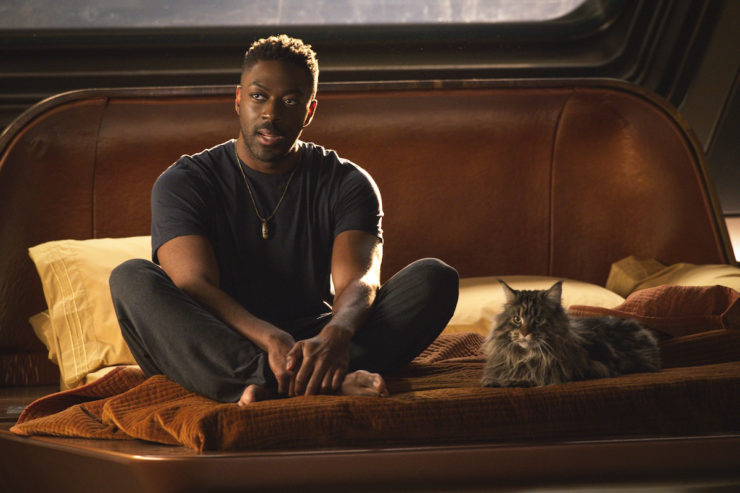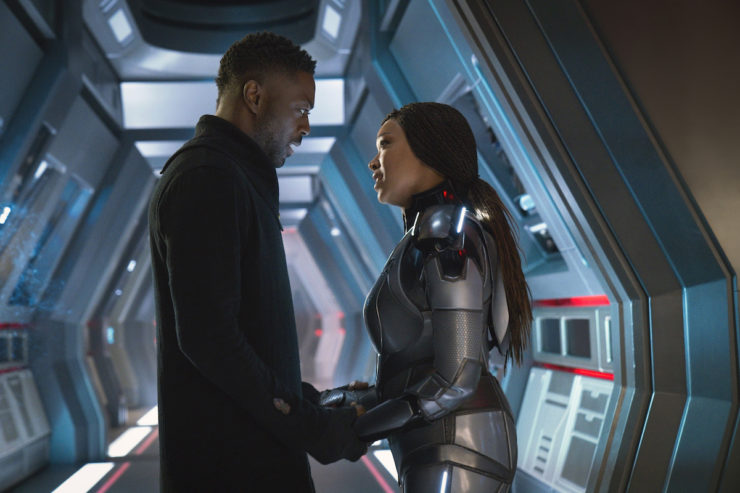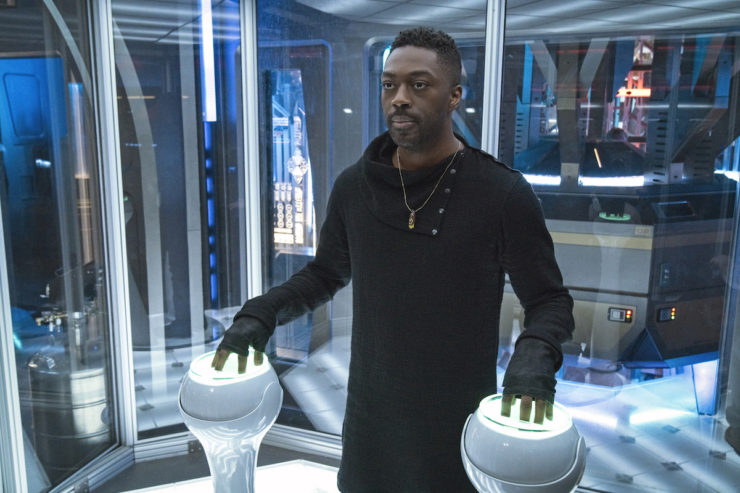There are four things I didn’t mention in my review of last week’s “The Examples” that I want to quickly mention…
The first is that I neglected to mention the second ship that was with the U.S.S. Janeway at the top of the episode when the DMA moved: the NSS T’Pau, named after the Vulcan matriarch introduced in the original series’ “Amok Time,” played by Celia Lovsky, and who also appeared in three Enterprise episodes, played by Kara Zediker, and in Voyager’s “Darkling” played by Betty Matsushita. Next is that the species who lived on the asteroid last week was the Akaali, introduced in Enterprise’s “Civilization” (which my rewatch of that show will get to in January).
The third is the weird thing on the back of Tarka’s neck that wasn’t explained. It’s not explained this week, either, as Tarka isn’t in the episode.
And then there’s Zora.
Zora, the Discovery computer that has been infused with the Sphere Data that was the cause of so much bother in season two, had a conversation with Burnham in “The Examples” that indicates that she’s gaining emotions.
This week, we dig into one of the old standbys of Trek, the artificial intelligence that gains emotions and therefore goes wonky. We saw this on the original series with Rayna in “Requiem for Methuselah” and on TNG with Lal in “The Offspring.” Luckily for Discovery, Zora doesn’t suffer the same fate as her two predecessors.
The issue here is that Zora is having trouble focusing, as she’s not used to having emotions, and so every little thing that happens on the ship becomes a cause for concern, to the point where she’s frozen because there’s so much going on and she’s worried about all of it.
Unfortunately, this emotional crisis occurs when Discovery is inside a subspace rift left behind by the DMA when it moved last week. The ship’s examination of this rift is, as Burnham puts it to Book at one point, a crime scene, in essence: there’s residue of various sorts in that subspace rift that might give them a clue as to where it came from.

The problem is that the interior of the rift has been changed and damaged by the DMA in ways the crew doesn’t expect. They read absolutely nothing inside the rift, which is weird enough, but they also don’t have a point of reference that will enable them to leave. An attempt to jump out via the spore drive fails because the rift is mucking about with the mycelial network. Worse, there’s a surge when Book tries to activate the drive that causes him to have hallucinations of his dead father.
The Book-and-his-father plot is pretty nowhere, a bog-standard argument-with-parent storyline that doesn’t tell us nearly enough about Book to be worth spending time on. Book argues with Burnham at the beginning of the episode that he should be making use of his extra-Federation contacts to find out more about the DMA, but Burnham needs to take advantage of the rift while it’s still there and the residue from the DMA is fresh. The hallucinatory Dad castigates Book for being subject to someone else instead of doing what he damn well pleases, but it’s just not that interesting or revelatory.
What is revelatory is what we learn about the DMA: it’s left behind particles that come from the great barrier that surrounds the galaxy, as seen in the original series’ “Where No Man Has Gone Before,” “By Any Other Name,” and “Is There in Truth No Beauty?” This means that the DMA is an extragalactic threat.
Of course, the crew has to report this to someone, and that requires that they get out of the rift, which requires that Zora get her shit together. It’s Gray—finally getting a plot use beyond Adira’s lost love—who realizes what’s wrong. He’s able to help Zora focus initially by playing a game with her, and in general Gray is invaluable in diagnosing Zora and helping her get a handle on emotions. Given Gray’s desire to become a Trill Guardian, this is good practice for him, and it’s a good use of the character for the plot. Not being a member of the crew, nor being the captain’s boyfriend who also has his own ship, he doesn’t really have much of a function when the ship goes to red alert inside the rift, and he’s initially talking to Zora mostly because he has nothing better to do but sit in the lounge waiting for something to happen.
Getting through the rift will be dangerous, as they don’t figure a way out until shields are almost gone, and they decide to do something that was established as a thing that could be done way back in “Day of the Dove” on the original series, but which was established as not workable long-term in TNG’s “Relics“: storing someone in the transporter buffer. It’s only for a couple minutes in “Day of the Dove,” and both “Relics” and TNG’s “Realm of Fear” made it clear that it’s not viable for an extended period as the pattern will degrade, but we’re several centuries past that, and transporter technology is so much better, so it makes perfect sense that they can just store people in the pattern buffer while they zip through an unsafe region.

Burnham stays, however, because she is the captain, and also because leaving your emotionally damaged computer in charge and all by herself isn’t the best idea. She wears an EVA suit, and risks her life, but that’s what captains do after all…
It’s been fascinating watching as the show slowly works things toward the 2018 Short Treks episode “Calypso,” an episode whose time frame has to be completely rethought in light of the events of the show since it aired. (It was assumed to be taking place in the thirty-third century, a thousand years after the present-day of the show when it aired, but now the show’s “present” is the thirty-second century. So now maybe “Calypso” takes place in the forty-second century?) First the computer gets the Sphere Data, then she takes on the name and personality that Annabelle Willis gave the computer in “Calypso,” and now we’re seeing her show the emotions that she displayed when bonding with Craft.
I’m still not happy that Saru has been positionally demoted to first officer, but at least he’s not being marginalized. He supervised Stamets and Tarka’s experiment last week (and had to be the grownup who kept the kids from blowing up the ship), and he’s in charge of the bridge when Owosekun has a nutty and tries to enact a rescue mission that would endanger her life—this after an ensign has already died thanks to a hull breach. Saru does an expert job of gently but firmly slapping Owosekun down, and then sending some DOT-23s to deal with the problem.
And that’s not even Saru’s best scene. That’s at the end when he and Book discuss anger and having difficulty in knowing where to place it. For Book it’s not knowing who’s responsible for the thing that wiped out his home. For Saru it’s sitting on the Kaminar Council alongside Ba’ul. For his entire life, the Ba’ul were the enemy, the ones responsible for the deaths of most of his family and friends by their manipulation of the vahar’ai. But now, Kelpiens and Ba’ul live in peace, and it’s very difficult for Saru to wrap his brain around. The gentle, encouraging talk he gives Book at the end is a tour de force for both Doug Jones and David Ajala. The latter in particular was not well served by an episode that resorted to tiresome bad-parents clichés, but it worked well in the end.
This episode makes beautiful use of the fictional history of the Trek universe, from the very first (successful) episode of the show in the use of the galactic barrier, through to Saru mentioning previous encounters with subspace rifts by the Enterprise and Voyager, to the lalogi orb from last week.

Inspired by the Akaali orb, which displays a literal family tree—a holographic tree with images of your family, both biological and found, on it—Burnham creates her own lalogi orb. We see several familiar faces on it: not just her parents Gabrielle and Mike, but also Sarek, Amanda, Spock (both as a child and as an adult), Book, and both versions of Georgiou. Zora at the end is similarly inspired, and she creates her own lalogi orb that includes the entire crew—even Tilly, who’s not currently assigned, and presumably others who aren’t currently on the ship anymore, either.
Discovery is at its best when the characters put their heads together to science the shit out of something, and there’s a lot of that here. My favorite is the bridge crew throwing ideas on how to get out of the rift at each other, though a close second is Detmer using her piloting skills to determine how far out the dangerous part of the rift is. And we do get that revelation about Owosekun’s having to sit helplessly watching someone die in her youth. While it, like learning about Rhys’ hurricane experience as a kid last week, feels a bit too expository in its delivery, at least we are learning things about the bridge crew. They’re not the main characters, after all, and hey, we’ve learned more about this bunch than we ever did Sulu, Chekov, or Uhura. And given the serialized nature of the show, as well as the shorter seasons, it’s a lot harder to give the secondary characters more to do. Still, every little bit helps, as does Oyin Oladejo’s convincingly emotional performance, both in her request of Saru and her later explanation.
(I have to say, though, that writing out Tilly at this point is really frustrating, as Mary Wiseman’s word-vomitty enthusiasm would’ve been perfect both in last week’s experiment and this week’s crisis.)
My favorite thing in the episode, though, was the use of the song “Stormy Weather,” which Zora sings to Burnham as they’re escaping the rift by way of returning the favor of distracting Burnham from a crisis. Wallis has a beautiful singing voice, and the song about a person succumbing to despair is a powerful touchstone for the episode’s theme. And best of all is that this time, the AI is able to live with the emotions, not be killed by them…
Keith R.A. DeCandido hopes everyone has a joyous holiday and a safe and healthy new year. Goodness knows, we could all use it…










